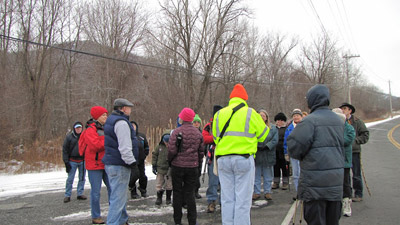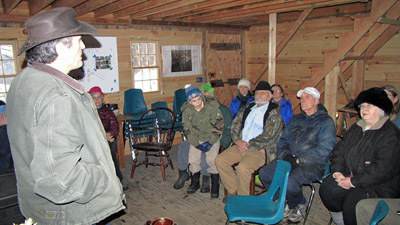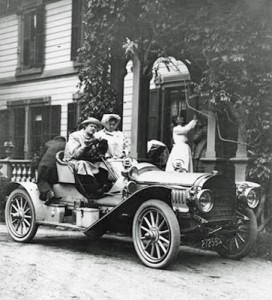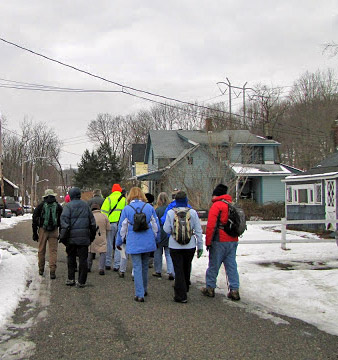There’s a bit of Highlands history nearly everywhere surrounding Sloatsburg. Author and regional archeologist Ed Lenik led a group of enthusiasts on an historic walk through Ramapo Hamlet this past New Year’s day, the 31st year that Lenik has held the gathering and the first walk in the Torne Valley.
 Past president of the Archeological Society of New Jersey and author of books, including Ramapough Mountain Indians and Iron Mind Trails, Lenik has celebrated each New Year by leading an historical Highlands walk, taking in some aspect of the area.
Past president of the Archeological Society of New Jersey and author of books, including Ramapough Mountain Indians and Iron Mind Trails, Lenik has celebrated each New Year by leading an historical Highlands walk, taking in some aspect of the area.
“Last year we started at Harmony Hall and did a walk through part of Sloatsburg,” said Harmony Hall Curator and attendee Geoff Welch. “Ed Lenik has been leading these hikes and historic walks for 31 years to celebrate the start of each year with an appreciation of local historic sites and nature.”
 The New Year adventure started off at the Ramapo Salbox house, officially called the Ramapo Saltbox Enrivonmental Research Center, nestled in Torne Valley in Hillburn. Chuck Stead hosted the morning gathering at the reconstructed 19th century structure, which resembles the type of worker housing that at one time existed in the hamlet.
The New Year adventure started off at the Ramapo Salbox house, officially called the Ramapo Saltbox Enrivonmental Research Center, nestled in Torne Valley in Hillburn. Chuck Stead hosted the morning gathering at the reconstructed 19th century structure, which resembles the type of worker housing that at one time existed in the hamlet.
The historical walk included stops at what was once Torne Valley Farm and is now Torne Valley Vineyards on Torne Brook Road. Built by Charles Pierson on a 15 acre swath of land bordered by Torne Brook and the Ramapo River, the estate  included a Victorian Gothic style main house that faced Torne Mountain. Eventually the property passed to Pierson’s niece Julia and her husband S. Herbert Mapes, who made the estate a jewel of the Highlands. The property was sold by the Mapes family in 1918 and throughout the years has served as a farm, religious retreat, apartments, and now a vineyard.
included a Victorian Gothic style main house that faced Torne Mountain. Eventually the property passed to Pierson’s niece Julia and her husband S. Herbert Mapes, who made the estate a jewel of the Highlands. The property was sold by the Mapes family in 1918 and throughout the years has served as a farm, religious retreat, apartments, and now a vineyard.
Listed on the National Register of Historic Places in 1988, the property was purchased in 2000 by two brothers, Jon and Stephen France, who have slowly returned the estate to its former glory. The once fertile farmland is now a working winery, one of the first in Rockland County, and event space.
The working estate and farm at one time had many amenities, including a horse track, tennis court, spectator pavilion, orchard, formal garden, and smoke house.
 The walking tour also included a pass through Ramapo Hamlet, which is being purchased by the Town of Ramapo, partially for historic preservation and for future development.
The walking tour also included a pass through Ramapo Hamlet, which is being purchased by the Town of Ramapo, partially for historic preservation and for future development.
The hamlet served as worker housing for industry in the area that included a nail factory and iron works named the Ramapo Works, which was in existence from 1795-1854. The Hamlet also later housed the Ramapo Car Works and the Ramapo Wheel and Foundry Company.
The site of a former cotton mill, built in 1816 by the Pierson family, still stands where the old bridge crosses the Ramapo River. The building has recently been renovated as warehouse space in use by a private company. The old bridge that leads from Rt. 17 into Ramapo Hamlet has been closed since Hurricane Irene flooded the area and caused structural damage.
In all the historical walk took in former workers’ houses, stone foundations, the 1816 Cottom Mill building, Torne Brook Farm, a raceway, sawmill site, and other scenic views in and around the Ramapo River.
Photos courtesy of Geoff Welch.


